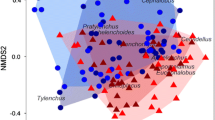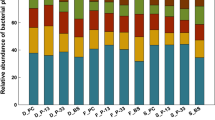Abstract
To elucidate whether the transgenic crop alters the rhizospheric bacterial community structure, a 2-year study was performed with Cry1Ac gene-inserted brinjal crop (Bt) and their near isogenic non-transformed trait (non-Bt). The event of Bt crop (VRBT-8) was screened using an insect bioassay and enzyme-linked immunosorbent assay. Soil moisture, NH4 +-N, NO3 −-N, and PO4 −-P level had non-significant variation. Quantitative polymerase chain reaction revealed that abundance of bacterial 16S rRNA gene copies were lower in soils associated with Bt brinjal. Microbial biomass carbon (MBC) showed slight reduction in Bt brinjal soils. Higher MBC values in the non-Bt crop soil may be attributed to increased root activity and availability of readily metabolizable carbon compounds. The restriction fragment length polymorphism of PCR-amplified rRNA gene fragments detected 13 different bacterial groups with the exclusive presence of β-Proteobacteria, Chloroflexus, Planctomycetes, and Fusobacteria in non-Bt, and Cyanobacteria and Bacteroidetes in Bt soils, respectively, reflecting minor changes in the community structure. Despite the detection of Cry1Ac protein in the rhizospheric soil, the overall impact of Cry1Ac expressing Bt brinjal was less compared to that due to seasonal changes.




Similar content being viewed by others
References
Acinus SG, Rupavtarm RS, Klepac-Ceraj V, Polz MF (2005) PCR-induced sequence artifacts and bias: insight from comparison of two 16S rRNA clone libraries constructed from the same sample. Appl Environ Microbiol 71:8966–8969
Ahmad N, Johri S, Abdin M, Qazi GN (2009) Molecular characterization of bacterial population in the forest soil of Kashmir, India. World J Microbiol Biotechnol 25:107–113
APHA (American Public Health Association) (1985) Standard methods for the examination of water and wastewater. American Public Health Association, Washington
Azadi H, Ho P (2010) Genetically modified and organic crops in developing countries: a review of options for food security. Biotechnol Adv 28:160–168
Barriuso J, Valverde JR, Mellado RP (2012) Effect of Cry1Ab protein on rhizobacterial communities of Bt-maize over a four-year cultivation period. PLoS One 7:e35481. doi:10.1371/journal.pone.0035481
Baumgarte S, Tebbe CC (2005) Field studies on the environmental fate of the Cry1Ab Bt-toxin produced by transgenic maize (MON810) and its effect on bacterial communities in the maize rhizosphere. Mol Ecol 14:2539–2551
Benedict JH, Altman DW (2001) Commercialization of transgenic cotton expressing insecticidal crystal proteins. In: Jenkins JN, Saha S (eds) Genetic improvement of cotton: emerging technologies. Science, Enfield, p 137
Broos K, Macdonald LM, Warne MSJ, Heemsbergen DA, Barnes MB, Bell M, McLaughlin MJ (2007) Limitations of soil microbial biomass carbon as an indicator of soil pollution in the field. Soil Biol Biochem 39:2693–2695
Bruinsma M, Kowalchuk GA, van Veen JA (2003) Effects of genetically modified plants on microbial communities and processes in soil. Biol Fert Soils 37:329–337
Brusetti L, Francia P, Bertolini C, Pagliuca A, Borin S, Sorlini C, Abruzzese A, Sacchi G, Viti C, Giovannetti L, Giuntini E, Bazzicalupo M, Daffonchio D (2004) Bacterial communities associated with the rhizosphere of transgenic Bt-176 maize (Zea mays) and its non transgenic counterpart. Plant Soil 266:11–21
Chadha KL (2001) Brinjal. Handbook of horticulture. ICAR, India, pp 356–359
Chen ZH, Chen LJ, Zhang YL, Wu ZJ (2011) Microbial properties, enzyme activities and the persistence of exogenous proteins in soil under consecutive cultivation of transgenic cottons (Gossypium hirsutum L.). Plant Soil Environ 57:67–74
Choudhary B, Gaur K (2009) The development and regulation of Bt Brinjal in India (Eggplant/Aubergine), ISAAA brief no 38. ISAAA, Ithaca
Crecchio C, Stotzky G (2001) Biodegradation and insecticidal activity of the toxin from Bacillus thuringiensis subsp. kurstaki bound on complexes of montmorillonite–humic acids–Al hydroxypolymers. Soil Biol Biochem 33:573–581
Dale PJ, Clarke B, Fontes EMG (2002) Potential for the environmental impact of transgenic crops. Nat Biotechnol 20:567–574
de Vries J, Heine M, Harms K, Wackernagel W (2003) Spread of recombinant DNA by roots and pollen of transgenic potato plants, identified by highly specific biomonitoring using natural transformation of an Acinetobactor sp. Appl Environ Microbiol 19:4455–4462
Devare MH, Jones CM, Thies JE (2004) Effect of Cry3Bb transgenic corn and tefluthrin on the soil microbial community: biomass, activity, and diversity. J Environ Quality 33:837–843
Devare M, Londono RLM, Thies JE (2007) Neither transgenic Bt maize (MON 863) nor tefluthrin insecticides adversely affect soil microbial activity or biomass: a 3-year field analysis. Soil Biol Biochem 39:2038–2047
Directorate General of Commercial Intelligence and Statistics, 2008. Annual report http://www.apeda.com
Fierer N, Jackson JA, Vilgalys R, Jackson RB (2005) Assessment of soil microbial community structure by use of taxon-specific quantitative PCR assays. Appl Environ Microbiol 71(7):4117–4120
Food and Agriculture Organization (FAO) Agriculture Database, 2005. http://faostat.fao.org
Ghareyazie B, Alinia F, Menguito CA, Rubia LG, de Palma JM, Liwanag EA et al (1997) Enhanced resistance to two stem borers in an aromatic rice containing a synthetic cry1a(b) gene. Mol Breed 3:401–414
Gschwendtner S, Reichmann M, Muller M, Radl V, Munch JC, Schloter M (2010) Effects of genetically modified amylopectin-accumulating potato plants on the abundance of beneficial and pathogenic microorganisms in the rhizosphere. Plant Soil 335:413–422
Gyamfi S, Pfeifer U, Stierschneider M, Sessitsch A (2002) Effects of transgenic glufosinate-tolerant oilseed rape (Brassica napus) and the associated herbicide application on eubacterial and Pseudomonas communities in the rhizosphere. FEMS Microbiol Ecol 41:181–190
Head G, Surber JB, Watson JA, Martin JW, Duan JJ (2002) No detection of Cry1Ac protein in soil after multiple years of transgenic Bt cotton (Bollgard) use. Environ Entomol 31:30–36
Hussain Q, Liu Y, Zhang A, Pan G, Li Z, Zhang X, Song X, Cui L, Jin Z (2011) Variation of bacterial and fungal community structures in the rhizosphere of hybrid and standard rice cultivars and linkage to CO2 flux. FEMS Microbiol Ecol 78:116–128
Icoz I, Saxena D (2008) Cry3Bb1 protein from Bacillus thuringiensis in root exudates and biomass of transgenic corn does not persist in soil. Transgenic Res 17:609–620
Icoz I, Saxena D, Andow D, Zwahlen C, Stotzky G (2008) Microbial populations and enzyme activities in soil in situ under transgenic corn expressing cry proteins from Bacillus thuringiensis. J Environ Qual 37:47–662
Icoz I, Stotzky G (2008) Fate and effects of insect-resistant Bt crops in soil ecosystems. Soil Biol Biochem 40:559–586
James C (2011) Global status of commercialized biotech/GM Crops: In: ISAAA brief no. 43, ISAAA, Ithaca
Jones DL, Hodge A, Kuzyakow Y (2004) Plant and mycorrhizal regulation of rhizodeposition. New Phytol 163:459–480
Knox OGG, Gupta VVSR, Nehl DB, Stiller WN (2007) Constitutive expression of cry proteins in roots and border cells of transgenic cotton. Euphytica 154:83–90
Lane DJ (1991) In: Stackebrant E, Goodfellow M (eds) 16S/23S rRNA sequencing. Nucleic acid techniques in bacterial systematic. Wiley, New York, pp 115–175
Lynch JM, Panting LM (1980) Cultivation and the soil biomass. Soil Biol Biochem 12:29–33
Miethling-Graff R, Dockhorn S, Tebbe CC (2010) Release of recombinant Cry3b1 protein of Bt maize MON 88017 into field soil and detection of effects on the diversity of rhizosphere bacteria. Eur J Soil Biol 46:41–48
Mishra A, Tyler G (1999) Influence of soil moisture on soil solution chemistry and concentrations of minerals in the Calcicoles Phleum phleoides and Veronica spicata grown on a limestone soil. Ann Botany 84:401–410
Motavalli PP, Kremer RJ, Fang M, Means NE (2004) Impact of genetically modified crops and their management on soil microbially mediated plant nutrient transformations. J Environ Qual 33:816–824
Muchaonyerwa P, Waladde P, Nyamugafata P, Mpepereki S, Ristori GG (2004) Persistence and impact on microorganisms of Bacillus thuringiensis proteins in some Zimbabwean soils. Plant Soil 266:41–46
NHB (National Horticulture Board), Government of India, New Delhi, http://nhb.gov.in/
Pal JK, Singh M, Rai M, Satpathy S, Singh DV, Kumar S (2009) Development and bioassay of Cry1Ac-transgenic eggplant (Solanum melongena L.) resistant to shoot and fruit borer. J Hortic Sci Biotechnol 84:434–438
Palm CJ, Donegan K, Harris D, Seidler RJ (1994) Quantification in soil of Bacillus thuringiensis var. kurstaki delta-endotoxin from transgenic plants. Mol Ecol 3:145–151
Rasche F, Hodl V, Poll C, Kandeler E, Gerzabek MH, van Elsas JD, Sessitsch A (2006) Rhizosphere bacteria affected by transgenic potatoes with antibacterial activities compared with the effects of soil, wild-type potatoes, vegetation stage and pathogen exposure. FEMS Microbiol Ecol 56:219–235
Rengel Z (2002) Genetic control of root exudation. Plant Soil 245:59–70
Rui KK, Yi GY, Zhao J, Wang BM, Li ZH, Zhai ZX, He P, Li Z (2005) Changes of Bt toxin in the rhizosphere of transgenic Bt cotton and its influence on soil functional bacteria. World J Microbiol Biotechnol 21:1279–1284
Sarkar B, Patra AK, Purakayastha TJ (2008) Transgenic Bt-cotton affects enzyme activity and nutrient availability in a sub-tropical Inceptisol. J Agro Crop Sci 194:289–296
Saxena D, Flore S, Stotzky G (1999) Insecticidal toxin in root exudates from Bt corn. Nature 402:480
Saxena D, Stewart CN, Altosaar I, Shu Q, Stotzky G (2004) Larvicidal cry proteins from Bacillus thuringiensis are released into root exudates of transgenic B. thuringiensis corn, potato, and rice but not of B. thuringiensis canola, cotton and tobacco. Plant Physiol Biochem 42:383–387
Saxena D, Stotzky G (2000) Insecticidal toxin in root exudates from Bt corn in vitro and in situ. FEMS Microbiol Ecol 33:35–39
Saxena D, Stotzky G (2001) Bacillus thuringiensis (Bt) toxin released from root exudates and biomass of Bt corn has no apparent effect on earthworms, nematodes, protozoa, bacteria and fungi in soil. Soil Biol Biochem 33:1225–1230
Schmalenberger A, Tebbe CC (2002) Bacterial community composition in the rhizosphere of a transgenic, herbicide-resistant maize (Zea mays) and comparison to its non-transgenic cultivar Bosphore. FEMS Microbiol Ecol 40:29–37
Sessitsch A, Gyamfi S, Tscherko D, Gerzabek MH, Kandeler E (2004) Activity of microorganisms in the rhizosphere of herbicide treated and untreated transgenic glufosinate-tolerant and wild type oil-seed rape grown in containment. Plant Soil 266:105–116
Shukla AK, Vishwakarma P, Upadhyay SN, Tripathi AK, Prasana HC, Dubey SK (2009) Biodegradation of trichloroethylene by methanotrophic community. Biores Technol 100:2469–2474
Smalla K, Wieland G, Buchner A, Zock A, Parzy J, Kaiser S, Roskot N, Heuer H, Berg G (2001) Bulk and rhizosphere soil bacterial communities studied by denaturing gradient gel electrophoresis: plant-dependent enrichment and seasonal shifts revealed. Appl Environ Microbiol 67:4742–4751
Tamura K, Dudley J, Nei M, Kumar S (2007) MEGA4: molecular evolutionary genetics analysis (MEGA) software version 4.0. Mol Biol Evol 24(2007):1596–1599
Tarafdar JC, Rathore I, Shiva V (2012) Effect of transgenic cotton on soil biological health. Appl Biol Res 14:15–23
Vance ED, Brookes PC, Jenkinson DS (1987) An extraction method for measuring soil microbial biomass C. Soil Biol Biochem 19:703–707
Vishwakarma P, Singh M, Dubey SK (2010) Changes in methanotrophic community composition after rice crop harvest in tropical soils. Biol Fert Soils 46:471–479
Xavier R, Rekha K, Bairy KL (2004) Health perspective of pesticide exposure and dietary management. Mal J Nutr 10:39–51
Zhang TH, Fang HP (2006) Application of real-time polymerase chain reaction for quantification of microorganisms in environmental samples. Appl Microb Biotechnol 70:281–289
Acknowledgments
This research work was supported by Indian Institute of Vegetable Research, India. One of the authors (AKS) is grateful to the Council of Scientific and Industrial Research, New Delhi, for financial assistance in the form of JRF and SRF. We are also grateful to anonymous reviewers whose constructive comments improved the manuscript.
Author information
Authors and Affiliations
Corresponding author
Electronic supplementary material
Below is the link to the electronic supplementary material.
ESM 1
(DOC 63 kb)
Rights and permissions
About this article
Cite this article
Singh, A.K., Rai, G.K., Singh, M. et al. Bacterial Community Structure in the Rhizosphere of a Cry1Ac Bt-Brinjal Crop and Comparison to Its Non-transgenic Counterpart in the Tropical Soil. Microb Ecol 66, 927–939 (2013). https://doi.org/10.1007/s00248-013-0287-z
Received:
Accepted:
Published:
Issue Date:
DOI: https://doi.org/10.1007/s00248-013-0287-z




